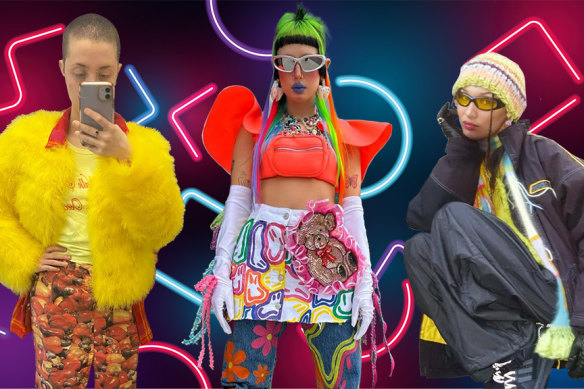Anyone partial to shows like Project Runway or RuPaul’s Drag Race will be familiar with the power of editing in fashion. The catchphrase “less is more” has been repeated ad nauseam, episode after episode. But a movement on TikTok begs to differ.
The latest trend to take over the social media platform is the ‘weird girl’ aesthetic – a style epitomised by mismatched patterns, kitschy accessories and as many textures as you can fit into one outfit.
The weird girl aesthetic rejects Kim Kardashian’s sleek minimalist look and embraces the multicoloured candy necklaces of the 90s. The more, there merrier in the world of the weird girl, and it doesn’t even have to match.
The aesthetic is not confined to the internet. Celebrities like Bella Hadid, as well as youth brand campaigns like Heaven by Marc Jacobs, have adopted looks replete with clashing colours, knitted beanies and chunky charm jewellery.
The ‘weird girl’ aesthetic has gained momentum on social media, but where did it come from and what does it mean?Credit:Instagram (@tinyjewishgirl, @saracampz, @bellahadid)
So, why the sudden interest in all things “ugly chic”? Regenerative fashion researcher and author of Sundressed, Lucianne Tonti, says this is not the first time we’ve bucked the trends.
“This maximalism and hyper-individualism reminds me of the excess after the Spanish flu,” Tonti tells The Age and Sydney Morning Herald.
“Post-crisis, we’re reminding each other that life can be a party, and we’re wearing that party how we want to. Whether that be bright hues, pants suits or hyper-individual chaos. Weird girl aesthetic is another expression of this.”
Tonti says the post-lockdown urge to stylistically explore is exacerbated by social media’s “hyper-speedy trend cycles”, as well as the accessibility of clothes from online fast-fashion, thrifting and “thrift-flipping”.
The fashion world is bombarded with new micro-trends on what feels like a weekly basis. Barbiecore, cottagecore, normcore, even goblincore – the suffix ‘core’ has been so overused that designers, stylists and general fashion enthusiasts groan at the sound.
“This moment in time is a perfect weird-girl storm,” Tonti says.
Although reminiscent of the ‘grunge meets school-girl’ Y2K era, mid-90s raver fashion, and the Harajuku movement – a Japanese aesthetic popularised by the street-style magazine FRUiTS in the late 90s and early 2000s – the weird girl aesthetic requires no prescriptive look. Instead, it blatantly rejects any fashion formula, merely requiring the wearer to adorn whatever they wish.
“I love it when fashion gets weird and takes us outside trends that make everybody look the same,” Tonti says. “Exploration and expressions of individuality push the industry – which can be extremely derivative – forward and that’s always a good thing.”
Most of the so-called weird girls are on the younger side, many of them Gen Z. Tonti says as a result of the tumultuous world we live in, this demographic has become known for its individualism and personal experimentation, all of which can flourish within the boundless realm of this aesthetic.
“There’s a very sweet rebellion in the Weird Girl aesthetic,” says Tonti.
“Gen Z are coming of age at a tough moment – from climate change to COVID and global political instability. They’ve also grown up online, so their lives have been extensively documented.
“While the rest of us have tried to present a perfectly curated life on Instagram, I think it makes sense for the next gen to push back on the world they’re inheriting and the pressure to conform.”
TikTok user Sara Camposarcone prefers to call her own weird girl aesthetic “sustainable maximalism”, where “more is more” but with little textile waste (thanks to second-hand and vintage shopping).
“This trend calls for fun. It’s an ‘anything goes’ kind of vibe,” Camposarcone tells The Age and Sydney Morning Herald. “Confidence is key to any outfit, and this aesthetic is one that allows you to express who you are, no matter what anyone else thinks.”
Camposarcone says personal style is not something that can develop overnight, and that it’s about much more than just the physical items of clothing.
“My style has changed quite a bit over the years, but I feel like the last few years during the pandemic allowed me the time and motivation to play around a bit more with my personal style,” she says. “I truly wear what makes me the happiest and what creatively expresses who I am the best.
“The ‘weird girl’ aesthetic today is unhinged in the best way possible. It shows confidence, power, individualism, and happiness all in one, and I think it’s a trend we all need in today’s world.”
Camposarcone’s socials are bathed in colour and kitsch, bringing dopamine dressing and ‘kidcore’ to levels unknown for her 75.4K Instagram followers and 739.6K TikTok followers. One notable piece is her barbie belt – a low-riding silver ring-belt with several undressed barbie dolls attached.
“I think sometimes we get stuck in trying to categorise ourselves into a specific genre or a specific aesthetic, and it’s really just as simple as wear whatever the hell you want.”
Although the burgeoning style could act as a stylistic nod towards freedom of expression, it doesn’t come without drawbacks. Former FRUiTs magazine photographer Daphne Mohajer va Pesaran says some partaking in the movement may miss out on the opportunity to appreciate the creators and characters from the Harajuku era.
“Fashion consumes itself all the time, recycling styles, turning real people and street culture into images to be used as research imagery for designers. The cycle continues,” Mohajer va Persaran says.
“Some people may not know about Harajuku street style with the front of their mind – so to speak – but they may have seen it already recycled.”
For Tonti, she worries about its sustainability, fearing the amount of waste generated from this kind of dressing is higher than other styles.
“The brightly coloured synthetic fabrics, the plastic glasses, the sweaters slashed into midriff tops – it’s unlikely any of it will ever be recycled, so it’s all destined for landfill and that hurts.
“But part of sustainability is wearing things that make you feel good and looking after clothes because you love them – hopefully the weird girls are keeping this in mind.”
Whether a turn to maximalism, an antidote to ‘pandemic blues’ or a result of an over-accelerated trend cycle, the weird girl aesthetic has navigated its way into the mainstream, perhaps making it less weird than the name suggests.
Make the most of your health, relationships, fitness and nutrition with our Live Well newsletter. Get it in your inbox every Monday.
Most Viewed in Lifestyle
From our partners
Source: Read Full Article

